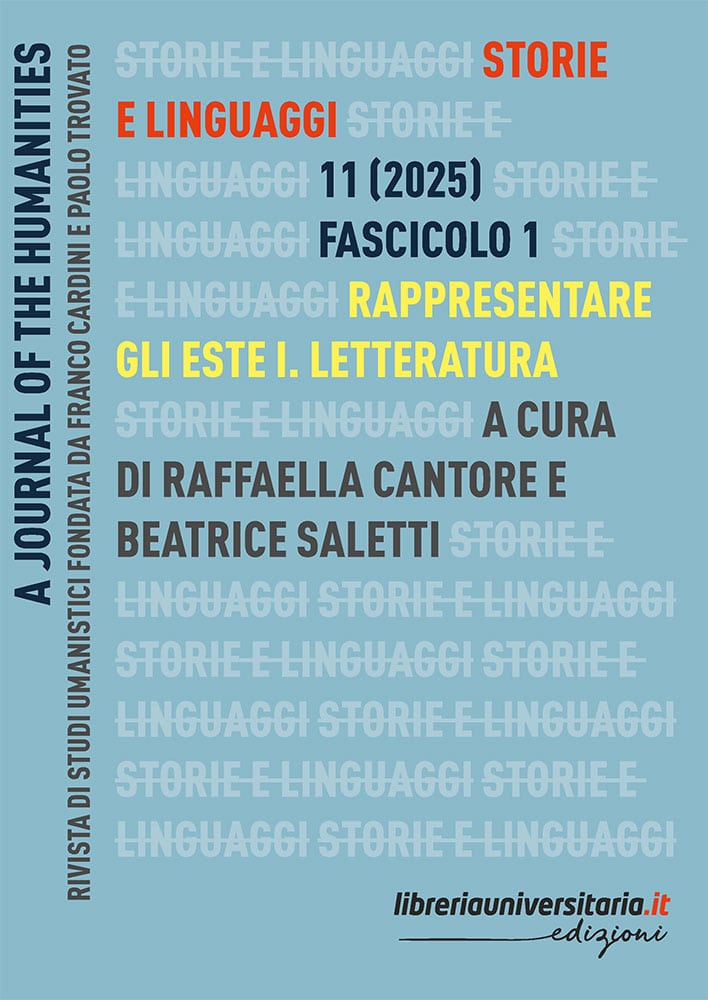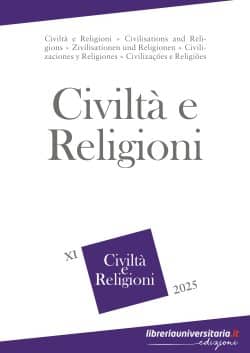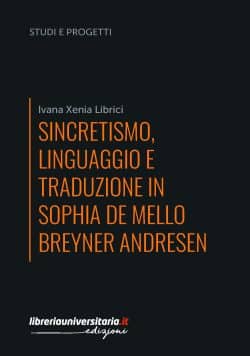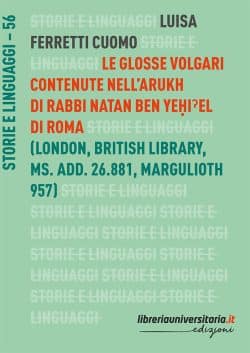Indice
French vernacular texts in Este Ferrara: new perspectives
ITA
Partendo da alcune riflessioni sulla circolazione della cultura e della letteratura francese alla corte degli Este tra Tre e Quattrocento, il saggio vuole indicare alcune piste di ricerca future sulla diffusione del francese in Italia che sono finora state poco esplorate. In particolare, si concentra su alcuni testi scritti in francese per un membro di casa d’Este, ovvero la Pharsale di Niccolò da Verona per Niccolò I e alcune canzoni di Guillaume Dufay in onore di Niccolò III e Leonello.
ENG
Starting with some reflections on the spread of French culture and literature at the court of the Este between the 14th and 15th centuries, this paper aims to indicate some future research lines on the dissemination of French in Italy which have been little explored so far. In particular, it focuses on some texts written in French for a member of the Este house, namely Niccolò da Verona’s Pharsale for Niccolò I and some songs by Guillaume Dufay in honor of Niccolò III and Leonello.
The Volgarizzamento antico of the Chronica parva written by Riccobaldo da Ferrara
ITA
Il Volgarizzamento antico si configura come la versione volgare più fedele e precoce della Chronica parva del notaio ferrarese Riccobaldo. Dotato di una sua estesa tradizione manoscritta, il volgarizzamento costituisce un prezioso strumento critico anche per la ricostruzione del testo latino con il quale è intrecciato ai piani alti dello stemma codicum. Inoltre, mantiene inalterata la vis antiestense con cui Riccobaldo narra la storia di Ferrara dalle origini della città fino all’affermazione di Obizzo II d’Este. Il presente contributo prova innanzitutto a identificare l’autore, il tempo e il luogo di confezionamento di questa versione in volgare partendo dall’analisi del testimone più antico conservato dell’intera tradizione latina e volgare: il marciano It. V, 229 (siglato V). In secondo luogo si interroga sul perché si sia conservato, anche fin dentro alla corte, un testo così avverso agli Estensi e su come collocarlo all’interno della produzione cronachistica e storiografica legata alla plurisecolare signoria estense.
ENG
The Volgarizzamento antico is recognized as the most faithful and earliest vulgar version of the Chronica parva by the notary Riccobaldo of Ferrara. It is preserved by a fairly extensive manuscript tradition, and this vulgarization serves as an important critical tool for reconstructing the Latin text with which it is intertwined at higher levels of the stemma codicum. Furthermore, it retains the unchanged anti-Estense sentiment with which Riccobaldo narrates the history of Ferrara, from the origins of the city to the rise of Obizzo II. This contribution primarily aims to identify the author, the time, and the place of composition of this vulgar version, based on an analysis of the oldest preserved witness of the entire Latin and vulgar tradition: the Marciano It. V, 229 (signed as V). Additionally, it examines why a text so critical of the Este family was preserved, even within the court, and how it fits within the chronicle and historiographical production related to the centuries-old Este lordship.
Forest and Attila in Nicolò da Càsola’s Attila Flagellum Dei
ITA
L’articolo presenta le principali figure antagoniste nell’ambito della tradizione letteraria in francese d’Italia (il più antico, duecentesco, Roman d’Atile en prose e il successivo, trecentesco, poema Attila Flagellum Dei) che vede la trattazione, in modo in larga parte inventato, dell’invasione della penisola italiana da parte di Attila. Si tratta di Attila stesso, di volta in volta identificato con il nemico storico contro il quale ci si trova a far fronte (Ezzelino da Romano nel Roman, i Visconti nel poema), e di Forest, progenitore degli Estensi (nel Roman il protagonista positivo fondamentale è solo Gilius, re di Padova, che appare poi anche nel poema). Dopo aver affrontato e contestualizzato le figure contrapposte di Attila e Forest, lo studio fa notare il parallelo tra quest’ultimo ed Ettore di Troia (dal Roman de Troie), particolarmente evidente nel racconto della morte dell’eroe. Si chiude con una breve rassegna di ulteriori possibili contatti tra il poema e altre tradizioni epiche: l’Aspremont e, nell’ambito del primo ciclo dei poemi della Crociata, l’Antioche.
ENG
This essay presents the medieval literary tradition written in Franco-italian which relates in a largely fictional manner the invasion of Italy by Attila the Hun: the XIIIth-century Roman d’Atile en prose and the XIVth-century poem Attila Flagellum Dei. This investigation focuses on the main figures of this tradition: Attila as the antagonist and Forest, ancestor of the Estensi family, as the positive protagonist in Attila Flagellum Dei (while this role in the Roman is played only by the king of Padua Gilius, who also appears in the poem). In these works, Attila is identified with the historical enemy the audience was confronted with at the time: Ezzelino da Romano in the Roman, the Visconti family in the poem. After presenting and contextualizing Attila and Forest, this study points out the intertextual relationship between Forest and Hector of Troy (from the medieval Roman de Troie), clearly evident within the passage of Forest’s death. The article closes with a short survey of possible contacts between Attila Flagellum Dei and other epic traditions: the Chanson d’Aspremont and the first-cycle-of-Crusade Chanson d’Antioche.
Niccolò II d’Este as a new Philadelphus in Donato del Casentino’s addition to Boccaccio’s De mulieribus claris
ITA
Il contributo intende offrire un approfondimento sul personaggio di Niccolò II d’Este, che suggerì a Donato del Casentino il volgarizzamento del De mulieribus claris di Boccaccio. Particolarmente significativa è stata a tal fine l’analisi della giunta di Donato al De mulieribus, poi tradotta e inserita in chiusura del volgarizzamento. In questa addizione Niccolò II d’Este è rappresentato come un grande bibliofilo ed è paragonato al grande sovrano egizio Tolomeo Filadelfo, che incentivò l’ampliamento della celebre biblioteca di Alessandria. Inoltre, Donato rappresenta se stesso nelle veci del suo bibliotecario, incaricato di cercare sempre nuovi libri per ampliare la biblioteca del marchese, “come un nuovo Demetrio”. La fonte antica che si cela dietro alla caratterizzazione dei personaggi è la Lettera di Aristea, diffusa nel Medioevo anche attraverso le Antichità giudaiche di Flavio Giuseppe.
ENG
This paper offers an in-depth analysis of the character of Niccolò II d’Este, who suggested to Donato del Casentino to translate Boccaccio’s De mulieribus claris. For this purpose, it is particularly relevant to analyse the depiction of the marquis Niccolò II in Donato’s final addition to the De mulieribus, both in the Latin and in the Vernacular versions. In this section, Niccolò II is presented as a great bibliophile and is compared to the Egiptian king Ptolemy II Philadelphus, who encouraged the expansion of the famous library of Alexandria. Furthermore, Donato represents himself in the place of Philadelphus’s librarian, who had the task to search new books everywhere to expand the marquis’ library, “like a new Demetrius”. The ancient source hidden behind the characterisation of Philadelphus and Demetrius is the Letter of Aristeas, widespread in the Middle Ages also through the Jewish Antiquities of Flavius Josephus.
Production and circulation of Greek and Latin manuscripts in Ferrara in the 15th century
ITA
Il saggio presenta alcune osservazioni intorno a manoscritti greci e latini presenti a Ferrara nel Quattrocento e ad alcune figure dell’Umanesimo ferrarese, quali Tommaso da Vicenza (allievo di Guarino Veronese), Guglielmo Capello, Ludovico Sandei, Ludovico Carbone. Presenta poi per la prima volta il dossier relativo ad alcuni officiali estensi, quali Tommaso Pavoni e Tommaso Sivieri, responsabili di visti doganali in codici latini. Si sofferma infine sulle annotazioni doganali di un officiale anonimo, presenti in due codici dell’umanista inglese Robert Fleming e in numerosi libri appartenuti al filosofo, medico e umanista Giovanni Marcanova (1410 ca. – 1467).
ENG
The essay presents some observations on Greek and Latin manuscripts found in Ferrara in the 15th century and on some figures of Ferrarese Humanism, such as Tommaso da Vicenza (a pupil of Guarino Veronese), Guglielmo Capello, Ludovico Sandei and Ludovico Carbone. It also presents for the first time the dossier on certain Este officials, such as Tommaso Pavoni and Tommaso Sivieri, responsible for customs notes in Latin codices. Finally, it dwells on the customs notes of an anonymous official, found in two codices of the English humanist Robert Fleming and in several books belonging to the philosopher, physician and humanist Giovanni Marcanova (c. 1410 – 1467).
Thalia and Agriculture: Greek sources for the revival of the Muse at the Este court
ITA
Nel XV secolo, il risveglio degli studi greci in Italia portò a un rinnovato interesse per le Muse, in particolare presso la corte di Leonello d’Este a Ferrara. Durante questo periodo, si osservò una significativa rilettura iconografica di Talia come Musa dell’Agricoltura, inventrice della piantagione e della floricoltura. Questo studio intende raccogliere e rileggere le fonti greche classiche e bizantine che contribuirono a questa evoluzione iconografica.
ENG
In the 15th century, the revival of Greek studies in Italy led to a renewed interest in the Muses, particularly at the court of Leonello d’Este in Ferrara. During this period, Thalia underwent a significant reinterpretation as the Muse of Agriculture, credited with the invention of planting and floriculture. This study aims to collect and reread the classical Greek and Byzantine sources that contributed to this iconographic evolution.
The Amphitryon and the Myth of Hercules in the Works of Pandolfo Collenuccio
ITA
Collenuccio volgarizza l’Anfitrione di Plauto per la corte estense, in occasione delle nozze di Lucrezia e Annibale Bentivoglio del 1487. L’adattamento presenta nel finale una lunga digressione d’autore, una rassegna di ventiquattro imprese di Ercole. L’articolo propone di rintracciare l’ipotesto principale di questa digressione nel catalogo delle trentuno «fatiche» di Ercole delle Genealogie di Boccaccio; questa fonte, con il suo portato metodologico evemeristico e le numerose imprese di Ercole interpretabili come azioni di governo, permette a Collenuccio di imbastire un paradigma mitico ideologicamente orientato, funzionale a rappresentare Ercole I d’Este come sovrano edificatore. La rappresentazione di Ercole come buon sovrano, sempre con finalità ideologico-propagandistiche, sarà poi indagata nella produzione volgare successiva dell’autore.
ENG
Collenuccio vulgarises Plautus’ Amphitryon for the Este court, on Lucrezia and Annibale Bentivoglio’s wedding in 1487. The adaptation presents a long author’s digression in the finale, a review of twenty-four exploits of Hercules. The article proposes to trace the main hypothesis of this digression back to the catalogue of the thirty-one ‘labours’ of Hercules in Boccaccio’s Genealogie; this source, with its evemeristic methodological bearing and the numerous feats of Hercules that can be interpreted as actions of government, allows Collenuccio to set up an ideologically oriented mythical paradigm, that is useful to represent Ercole I d’Este as a sovereign builder. The representation of Hercules as a good ruler, again with ideological-propaganda purposes, will be investigated in the author’s later vernacular production.
From Ferrara to Washington: two Greek poems in a manuscript by the court historian Alessandro Sardi
ITA
Il contributo offre la prima edizione, traduzione e commento di due carmi greci per Ippolito e Orazio Malaguzzi, presenti nel manoscritto Washington, Folger Shakespeare Library, Folger V. a. 123, un codice miscellaneo compilato da Alessandro Sardi nel XVI secolo.
ENG
This paper provides the first edition, translation, and commentary of two Greek poems dedicated to Hippolytus and Horace Malaguzzi, preserved in ms. Washington, Folger Shakespeare Library, Folger V. a. 123, a miscellaneous codex compiled by Alessandro Sardi in the 16th century.
The Triumphale opus by Antonio de’ Conti: a case of Renaissance plagiarism
ITA
Il saggio tratta del Triumphale opus di Antonio de’ Conti, trasmesso dal ms. 1355 della Biblioteca Teresiana di Mantova e dedicato a Isabella d’Este. Le informazioni sull’autore sono scarse: era un conte padovano, un cavaliere e un giureconsulto. Il codice è databile al 1493 ed è un elogio della dedicataria, che ricorda i Trionfi del Petrarca. Da ulteriori ricerche è emerso che il Triumphale opus è un plagio da un testo di Benedetto da Cingoli.
ENG
The essay deals with Triumphale opus by Antonio de’ Conti, transmitted in ms. 1355 of the Teresiana Library of Mantua and dedicated to Isabella d’Este. There is little information about the author: he was a Paduan count, a knight and a jurisconsult. The codex can be dated back to 1493 and it’s a eulogy of the dedicatee, recalling the Triumphs of Petrarch. Upon further research, Triumphale opus was proved to be a plagiarism from a text by Benedetto da Cingoli.
“Decus Italiae”: the communication of power in Laudivio Zacchia’s “De captivitate ducis Iacobi”
ITA
L’articolo analizza la tragedia umanistica De captivitate ducis Iacobi di Laudivio Zacchia, scritta nel 1465. L’opera tratta dell’uccisione del condottiero Iacopo Piccinino da parte del re di Napoli Ferdinando I. L’episodio suscitò scalpore nelle corti italiane, soprattutto a Ferrara: ciò dà a Zacchia l’opportunità di scrivere una tragedia che esalta la lungimiranza di Borso d’Este, descritto come protagonista. Il saggio spiega le strategie encomiastiche e ideologiche impiegate dal poeta e individua le motivazioni politiche della tragedia.
ENG
The article analyzes the humanistic tragedy De captivitate ducis Iacobi by Laudivio Zacchia, written in 1465. The work discusses the killing of the condottiero Iacopo Piccinino by the King of Naples, Ferdinand I. The episode caused stir in the Italian courts, especially in Ferrara: this gives to Zacchia the opportunity to craft a tragedy that extols the foresight of Borso d’Este, depicted as the protagonist. The essay explains the encomiastic and ideological strategies employed by the poet and identifies the political motivations of the tragedy.
Notes on the versified chronicle of Ugo Caleffini
ITA
L’articolo analizza brevemente i modelli letterari, la retorica e la prosodia della Cronica in versi confrontandola con altri poemetti della stessa area culturale e suggerisce che Caleffini possa aver letto la Spagna ferrarese nell’esemplare di dedica a Borso d’Este.
ENG
The article briefly analyzes the literary models, rhetoric and prosody of the Cronica in versi comparing it with other poems from the same cultural area and suggests that Caleffini may have read the Spagna ferrarese in the dedication copy of Borso d’Este.
The Este propaganda of Antonio Cornazzano between a revival of classicism and a look at the present
ITA
Antonio Cornazzano si distingue tra gli scrittori cortigiani del XV sec. per la sua capacità di adattare i tratti del genere encomiastico alla situazione contingente, quindi alla corte in cui si trova in quel momento e alle esigenze pubblicistiche del signore locale (Cornazzano ha frequentato le corti di Francesco Sforza, di Bartolomeo Colleoni e di Ercole I d’Este), con una capacità di comunicazione che si avvale della cultura contemporanea spaziando attraverso generi letterari e artistici diversi. Il saggio mette in luce come all’interno delle opere encomiastiche scritte per gli Estensi Cornazzano abbia saputo piegare la sua cultura classica e la sua conoscenza della realtà storico-politica contemporanea alle esigenze di propaganda politica del signore a cui dedica la singola opera, riproponendo spesso in modo nuovo temi e topoi già ampiamente adottati anche in opere encomiastiche per altri signori. Sono presi in esame i capitoli ternari del De excellentium virorum principibus ab origine mundi per Borso d’Este; il De Herculeii filii ortu et de urbis Ferrariae periculo ac liberatione (1476) e il De la integrità de la militare arte (1476-1478) per Ercole I; e infine per Eleonora d’Aragona il trattatello in terza rima Del modo di regere ed regnare (1478 ca).
ENG
Antonio Cornazzano stands out among 15th-century courtier writers for his ability to adapt the features of the encomiastic genre to the contingent situation, thus to the court in which he found himself at the time, and to the publicistic needs of the local lord (Cornazzano frequented the courts of Francesco Sforza, Bartolomeo Colleoni, and Ercole I d’Este). His communication skills made use of classical and contemporary culture and ranged across different literary and artistic genres. The essay highlights how within the encomiastic works written for the Este family Cornazzano was able to bend his classical culture and his knowledge of contemporary historical-political reality to the political propaganda needs of the lord to whom he dedicates the individual work, often re-proposing in new ways themes and topoi already widely adopted even in encomiastic works for other lords. Examined are the ternary chapters of De excellentium virorum principibus ab origine mundi for Borso d’Este; the De Herculeii filii ortu et de urbis Ferrariae periculo ac liberatione (1476) and De la integrità de la militare arte (1476-1478) for Ercole I; and finally for Eleonora of Aragon the little treatise in terza rima Del modo di regere ed regnare (c. 1478).
Cornazzano’s “Life of Borso”: between catalogic and encomiastic tradition
ITA
Antonio Cornazzano è stato uno dei numerosi poeti che hanno voluto omaggiare il duca Borso con l’obiettivo di guadagnare o di consolidare una posizione privilegiata presso la corte estense e per questo compone il De excellentium, in volgare e in latino. L’articolo esplora la rappresentazione di Borso in quest’opera e in particolare nella sezione che Cornazzano rubrica come Vita di Borso: non si tratta di una biografia, ma di un panegirico cortigiano con cui Cornazzano dimostra di saper sfruttare i temi cari alla propaganda estense di quegli anni.
ENG
Antonio Cornazzano was one of numerous poets who sought to pay homage to Duke Borso with the objective of securing or reinforcing a privileged position at the Este court. To this end, he composed the De excellentium, which was written in both the vernacular and Latin. This article examines the portrayal of Borso in the work, with a particular focus on the section referred to by Cornazzano as the Vita di Borso (‘Life of Borso’). It should be noted that this is not an actual biography, but rather a courtier panegyric in which Cornazzano demonstrates his ability to exploit the themes dear to the Este propaganda.
The birth of Alfonso I d’Este in a Latin poem by Ludovico Pittorio
ITA
Il saggio propone l’edizione critica di un’elegia indirizzata dal poeta ferrarese Ludovico Bigo Pittorio ad Ercole I d’Este per commemorare la nascita di suo figlio Alfonso. Il carme, stampato nella seconda raccolta di Pittorio, i Tumultuaria carmina (1492), è tràdito, in una redazione differente, anche in un codice ferrarese, il ms. Classe I 396 della Biblioteca Ariostea di Ferrara. Si correda il testo di una lettura critica, volta a fornirne la necessaria contestualizzazione, sia dal punto di vista storico-culturale che letterario.
ENG
The essay proposes the critical edition of an elegy addressed by Ludovico Bigo Pittorio, a poet born in Ferrara, to Ercole I d’Este to commemorate the birth of his son Alfonso. The elegy was printed in Pittorio’s second poetic collection, Tumultuaria carmina (1492), but it has also been handed down, in a different redaction, in the ms. Classe I 396 of the Ariostea Library in Ferrara. The text is accompanied by a critical reading, aimed at providing the historical and literary contextualization of the poem.
The Frottolla contra li papeschi da Ferrara (1510-1511)
ITA
L’articolo propone l’edizione di una Frottolla contra li papeschi da Ferrara stampata da Lorenzo Rossi tra il 1510 e il 1511 e giuntaci in un solo esemplare (Milano, Biblioteca Trivulziana, Triv. Inc. C 259/50). Contestualmente all’edizione, si fornisce un inquadramento della Frottolla nell’ambito della guerra di Giulio II contro Ferrara.
ENG
The article presents the edition of the Frottolla contra li papeschi da Ferrara, printed by Lorenzo Rossi between 1510 and 1511, of which only one copy survives (Milan, Biblioteca Trivulziana, Triv. Inc. C 259/50). At the same time, this work situates the Frottolla within the historical context of Pope Julius II’s campaign against Ferrara.
Searching for Justice in Ariosto’s Letters
ITA
A differenza dei suoi contemporanei di formazione umanistica, che utilizzavano Cicerone e Petrarca come modelli epistolari, Ariosto scrisse la maggior parte delle sue Lettere, soprattutto quelle composte in Garfagana dove prestò servizio come funzionario regionale per il governo estense dal 1522-1525, per comunicare documenti amministrativi essenziali. Ma in tutte le Lettere, per quanto possano sembrare banali e burocratiche, Ariosto commenta regolarmente anche la giustizia, o la sua mancanza, e cerca di porre rimedio alle ingiustizie di cui è testimone. Le Lettere documentano i limiti della visione morale e dell’efficacia dell’autore nella sfera politica.
ENG
Unlike his humanistically-trained contemporaries who used Cicero and Petrarch as epistolary models, Ariosto wrote the vast majority of his Letters, especially those composed in the Garfagana where he served as a regional official for the Estense government from 1522-1525, to communicate essential administrative records. But throughout his Letters, however mundane and bureaucratic they may seem, Ariosto also regularly comments on justice, or the lack of it, and seeks to remedy the injustices he witnesses. The Letters document the limits of the author’s moral vision and effectiveness in the political sphere.
ITA
La figura del barone ribelle, ereditata dall’epica francese medievale, è stata notevolmente trasformata nell’epica romanzesca italiana, ma non ha mai perso la sua forza generativa. La figura è presente come sottotesto costitutivo nei personaggi di Ariosto, Orlando e Rodomonte, creando una tensione significativa tra le forme narrative ricevute e le mutevoli realtà politiche. Rinaldo nella Gerusalemme liberata va letto anche in continuità con la tradizione del barone ribelle. Il progetto di mitopoiesi dinastica di Tasso, la reintegrazione del ribelle e l’elevazione di Rinaldo a capostipite degli Estensi, può quindi essere inquadrato nei termini di una consapevole dialettica di generi letterari e strutture narrative.
ENG
The figure of the rebel baron, as inherited from medieval French epic, was greatly transformed in Italian romance epics, but never lost its generative force. The figure is present as a constitutive subtext in Ariosto’s characters Orlando and Rodomonte, creating meaningful tension between received narrative forms and changing political realities. Rinaldo in Gerusalemme liberata should also be read in continuity with the rebel baron tradition. Tasso’s project of dynastic mythopoesis, his reintegration of the rebel and elevation of Rinaldo as the Este’s progenitor, may thus be framed in terms of a highly conscious dialectic of literary genre and narrative structures.





